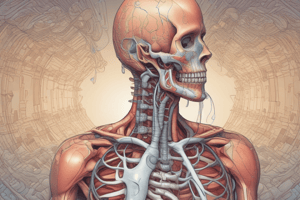Podcast
Questions and Answers
What is the term for the inability of the body to move gas effectively?
What is the term for the inability of the body to move gas effectively?
- Anemia
- Respiratory compromise (correct)
- Hypoxia
- Cardiac arrest
What are the components of the brain stem?
What are the components of the brain stem?
Midbrain, medulla, pons
Which part of the autonomic nervous system dominates during rest?
Which part of the autonomic nervous system dominates during rest?
- Peripheral nervous system
- Parasympathetic nervous system (correct)
- Sympathetic nervous system
- Central nervous system
What is the patient's blood pressure if it is 100/60 mm Hg?
What is the patient's blood pressure if it is 100/60 mm Hg?
Signs of decompensated shock include a decreased level of consciousness, ashen skin, and _____ pulses.
Signs of decompensated shock include a decreased level of consciousness, ashen skin, and _____ pulses.
How is carbon dioxide transported in the blood?
How is carbon dioxide transported in the blood?
Medications delivered intravenously have the fastest onset of action.
Medications delivered intravenously have the fastest onset of action.
Match the following assessments with their conditions:
Match the following assessments with their conditions:
Which of the following is a sign of hypoxia?
Which of the following is a sign of hypoxia?
Flashcards are hidden until you start studying
Study Notes
Chapter 6 Assessment
- Respiratory compromise affects gas movement in the body and can lead to cell death due to lack of oxygen.
- Critical organs such as the heart and brain require constant oxygen supply; anaerobic metabolism occurs in oxygen-deprived conditions, resulting in lactic acid buildup and blood pH drop.
- The brain stem, comprising the midbrain, pons, and medulla, oversees consciousness and vital sign regulation.
- The autonomic nervous system has two components: the sympathetic (activated under stress) and the parasympathetic (dominant during rest), with the brain stem aiding heart rate control.
Chapter 9 Assessment
- Ensuring scene safety is paramount; if unsafe, retreat and seek assistance.
- Vital signs indicated: blood pressure at 100/60 mm Hg, tachycardia at 140 bpm, and increased respirations at 24 breaths/min with noted abdominal tenderness.
- Patient exhibits symptoms of fever, chills, vomiting, and diarrhea.
- The SAMPLE mnemonic is essential for thorough patient assessment and history-taking.
Chapter 10 Assessment
- Cellular respiration involves oxygen exchange at the cellular level; aerobic metabolism produces energy, water, and carbon dioxide, while anaerobic metabolism leads to inefficient energy production and lactic acid accumulation.
- Ventilation is the mechanical act of breathing; oxygenation occurs within cells via hemoglobin transport.
- Shallow respirations at a rate of 6 breaths per minute necessitate assisted ventilations to prevent hypoxia and ensure tissue perfusion.
Chapter 11 Assessment
- Medications given intravenously have the fastest onset of action compared to other administration routes.
- Patient medication history must be thoroughly collected, as they can significantly impact current health conditions.
Chapter 12 Assessment
- Decompensated shock signs include altered consciousness, ashen or cyanotic skin, weak pulses, irregular respirations, and low systolic blood pressure (<90 mm Hg).
- Shock, or hypoperfusion, indicates circulatory failure leading to inadequate tissue function.
- Carbon dioxide return to the lungs occurs through plasma dissolution, bicarbonate formation, or attachment to hemoglobin.
- A sense of impending doom may indicate a patient approaching death, a potential sign of decompensated shock.
Chapter 13 Assessment
- Four specific scenarios to cease resuscitation: patient regains spontaneous breathing and circulation, care transfer, exhaustion, or medical directive.
- Gastric distention from rapid ventilations can induce vomiting or hinder breath delivery due to diaphragm pressure.
Chapter 14 Assessment
- Key questions for patient travel history: destinations, vaccinations, and drinking water sources.
- Potential infectious threats: HIV, hepatitis B, meningitis, tuberculosis, H1N1, MERS-CoV, and Ebola.
- Substances that may mislead patient health assessment include alcohol, caffeine, over-the-counter medications, herbal supplements, and recreational drugs.
Chapter 15 Assessment
- Cigarette smoking is a significant risk factor for various respiratory conditions.
- Symptoms of respiratory distress include dyspnea, acute chest pain, hemoptysis, cyanosis, tachycardia, and varying hypoxia levels.
Chapter 16 Assessment
- Understanding patient symptoms and scenarios critical for proper diagnosis and treatment protocols.
Studying That Suits You
Use AI to generate personalized quizzes and flashcards to suit your learning preferences.




